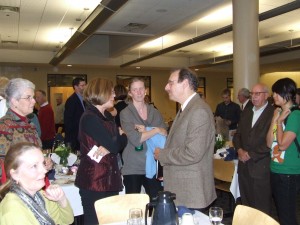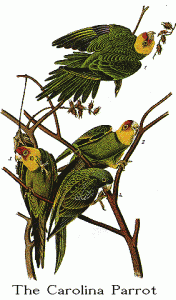
Audience members line up to talk to Dr. Graf after his lecture at the Nobel Conference Banquet.
Geographer Will Graf of the University of South Carolina gave the culminating lecture at the Nobel Conference 45 Banquet on October 7. His talk, “Where the Wild Things Are: Dams, Rivers, and Wildlife Preservation,” was a beautifully structured and informative overview of the state of dams and welfare of wildlife dependent on river systems in the United States.
Dr. Graf spoke of our “innate love of wild things” and how the loss of species like the Carolina parrot, once a native of the Missouri River, serves to diminish us as individuals and a society. We need natural places, not just for wildlife habitat, but because they are the places where we can ask the “truly transcendental questions” of life.
With over 80,000 dams on our nation’s rivers and streams, we have drastically altered the water cycle. Changing a river’s flow regime usually means that the downstream landscape is simplified and the areas affected by the river and the nutrients and sediment it carries grow smaller. This has large and often detrimental affects on wildlife such as fish and birds.
But, Graf argues, dams can also be used to help restore habitat if we can get the water, the landscape, and our values right. We should add to dam goals the goal of re-establishing habitat. This can be done through changing the dam release schedule, mechanically altering the dam, or removing the dam entirely.


Parrots in Ohio? Yes, this now-extinct bird was once native to many areas of the United States.
Some challenges that face us include: To what shall we restore a river? What should be considered “natural”? How do we monetarily evaluate ecosystems? How do we keep up political pressure to create change? And which of the two very American but very conflicting values will prevail–consumption or preservation? The last question was on the “exam” Dr. Graf gave the audience toward the end of his talk–an exam, as he pointed out, that we will continue to be subject to and that will continue to have very important repercussions for our world.
The Gustavus community and especially the Geography Department are so pleased that Dr. Graf was able to participate in this year’s Nobel Conference. As one Gustie Geography student said, meeting Professor Graf and attending the Nobel Conference was “the most fun I’ve had in a long time.”
Go Graf! Go Gusties! Go Geography!
To listen to Dr. Graf’s Nobel lecture, click on this link: http://gustavus.edu/events/nobelconference/2009/presenters.php#graf.
(Okay, okay, so there were some other great lectures at this year’s Nobel Conference as well. They can all be accessed via the link above. Anna especially recommends the lecture by David Sedlak in which he explains how you can drink water from your toilet–but don’t try this at home–and the lecture by Nancy Rabalais in which she explains the connection between Minnesota corn farmers and Louisiana shrimp catchers–and, no, it’s not a joke. Dr. Rabalais’ lecture has the added attraction of an unplanned encounter between a spider and Gustavus President Jack Ohle. How’s that for a teaser?)